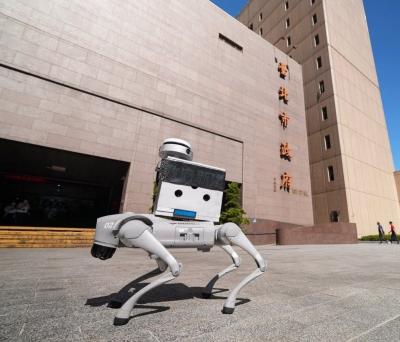National Cheng Kung University (NCKU) has unveiled a new artificial intelligence (AI) powered system that can detect people drowning in water.
The system was developed by a team led by NCKU Department of Hydraulic and Ocean Engineering professor Doong Dong-jiing (董東璟), who demonstrated the technology at Sunset Platform in Tainan’s Anping District (安平) on Saturday.
The AI-powered equipment combines high-precision optic cameras with deep-learning algorithms that can detect someone drowning in a body of water near where the system is installed.

Photo courtesy of the National Cheng Kung University
Upon detecting anomalies such as signals for help or prolonged submersion under water, the system alerts on-duty lifeguards or the system’s management to initiate rescue protocols.
The system can also monitor people at beaches where it is installed, the first time AI has been incorporated into safety detection efforts at beaches, Doong said.
At the demonstration of the system, NCKU presented its capabilities in identifying beachgoers and discerning between activities such as windsurfing, paddleboarding and people riding water scooters.
The system issued alerts when swimmers crossed beyond the safety boundaries of the beach and when a demonstrator pretended to drown.
With beaches sometimes being crowded with hundreds or thousands of people, it is difficult for lifeguards to monitor their surroundings at all times, he said.
However, with the AI drowning detection system, first responders can receive rescue alerts before it is too late, he said.
The system is versatile enough to be installed near swfimming pools, streams, ponds and even reservoirs to prevent drowning, he added.
The university said in a statement said that the team has proven the system’s accuracy and reaction speed by testing it in many different locations.
The tests have shown how practical the system is, the university said, adding that it hopes to see the technology incorporated near Taiwan’s coasts soon to help prevent people from drowning.
Last year, 554 people in Taiwan died from drowning, Ministry of the Interior data showed.

The inspection equipment and data transmission system for new robotic dogs that Taipei is planning to use for sidewalk patrols were developed by a Taiwanese company, the city’s New Construction Office said today, dismissing concerns that the China-made robots could pose a security risk. The city is bringing in smart robotic dogs to help with sidewalk inspections, Taipei Deputy Mayor Lee Ssu-chuan (李四川) said on Facebook. Equipped with a panoramic surveillance system, the robots would be able to automatically flag problems and easily navigate narrow sidewalks, making inspections faster and more accurate, Lee said. By collecting more accurate data, they would help Taipei

STATS: Taiwan’s average life expectancy of 80.77 years was lower than that of Japan, Singapore and South Korea, but higher than in China, Malaysia and Indonesia Taiwan’s average life expectancy last year increased to 80.77 years, but was still not back to its pre-COVID-19 pandemic peak of 81.32 years in 2020, the Ministry of the Interior said yesterday. The average life expectancy last year increased the 0.54 years from 2023, the ministry said in a statement. For men and women, the average life expectancy last year was 77.42 years and 84.30 years respectively, up 0.48 years and 0.56 years from the previous year. Taiwan’s average life expectancy peaked at 81.32 years in 2020, as the nation was relatively unaffected by the pandemic that year. The metric

TAKING STOCK: The USMC is rebuilding a once-abandoned airfield in Palau to support large-scale ground operations as China’s missile range grows, Naval News reported The US Marine Corps (USMC) is considering new sites for stockpiling equipment in the West Pacific to harden military supply chains and enhance mobility across the Indo-Pacific region, US-based Naval News reported on Saturday. The proposed sites in Palau — one of Taiwan’s diplomatic allies — and Australia would enable a “rapid standup of stored equipment within a year” of the program’s approval, the report said, citing documents published by the USMC last month. In Palau, the service is rebuilding a formerly abandoned World War II-era airfield and establishing ancillary structures to support large-scale ground operations “as China’s missile range and magazine

A 72-year-old man in Kaohsiung was sentenced to 40 days in jail after he was found having sex with a 67-year-old woman under a slide in a public park on Sunday afternoon. At 3pm on Sunday, a mother surnamed Liang (梁) was with her child at a neighborhood park when they found the man, surnamed Tsai (蔡), and woman, surnamed Huang (黃), underneath the slide. Liang took her child away from the scene, took photographs of the two and called the police, who arrived and arrested the couple. During questioning, Tsai told police that he had met Huang that day and offered to